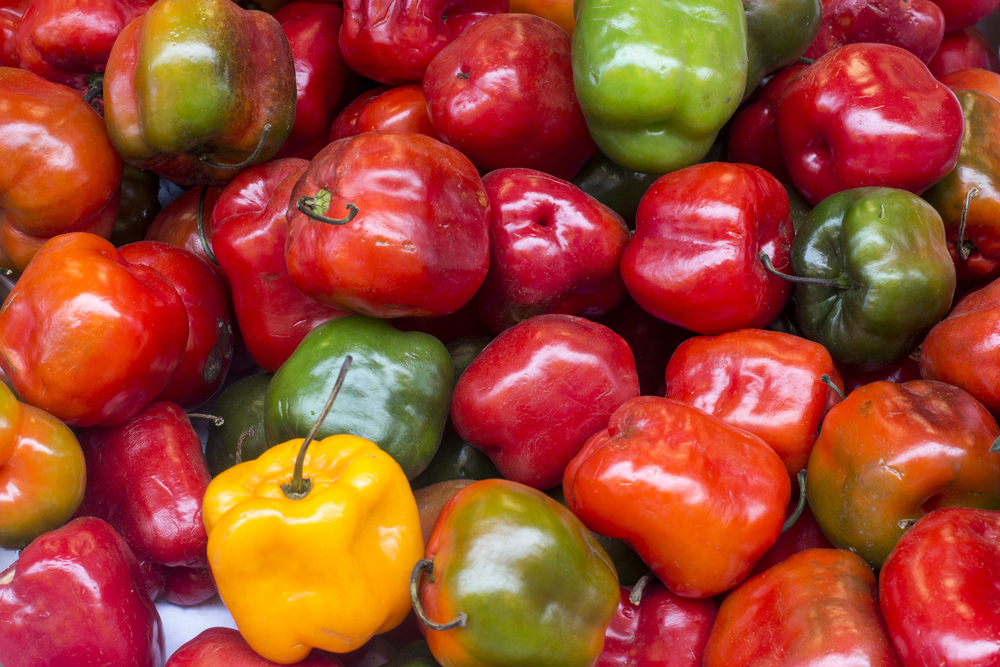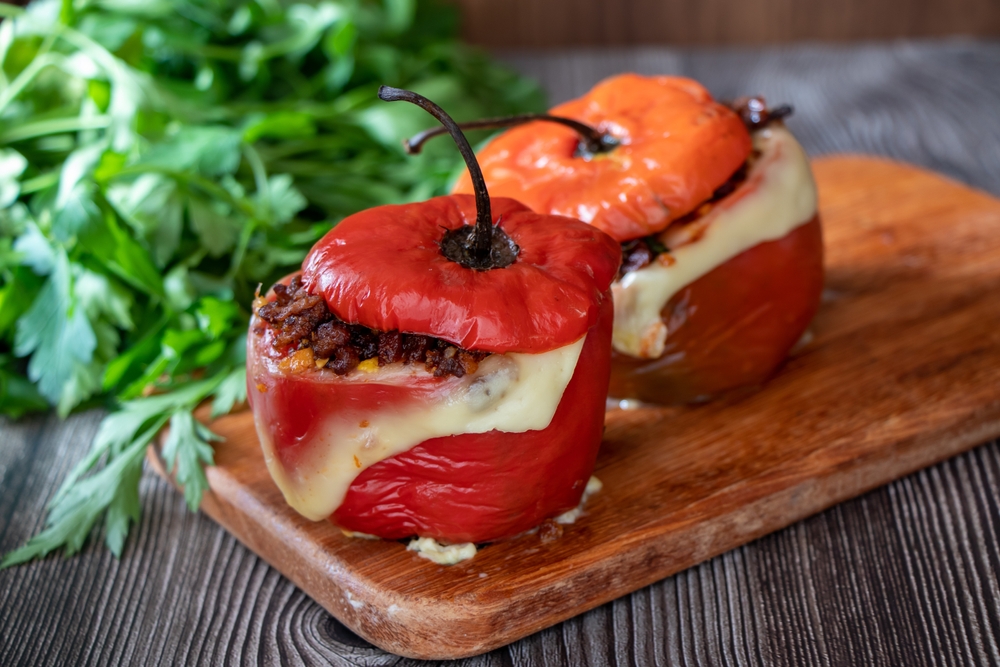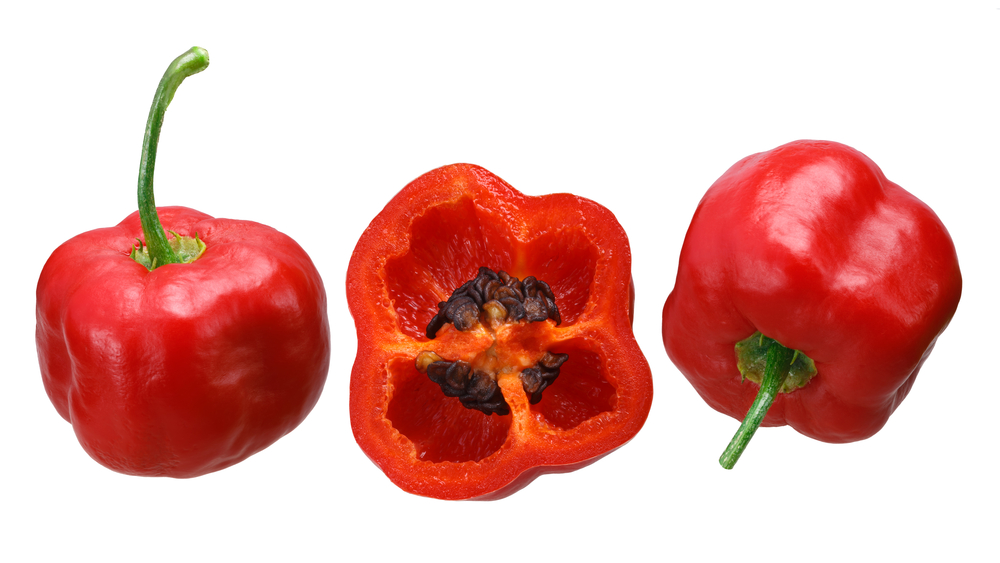Rocoto peppers are South American hot peppers in the Capsicum pubescens species. They are famous for their medium heat, juiciness, longevity as a perennial pepper, rich history as one of the oldest domesticated peppers, and their ability to thrive in cooler temperatures.
What Is A Rocoto Pepper?
A rocoto pepper is a Peruvian apple-shaped or pear-shaped hot pepper grown in Peru, Ecuador, Bolivia, Chile, and Colombia. It’s also grown in the highlands of Mexico and Central America. The pepper is a staple in Peruvian cuisine for its versatility, spiciness, and juiciness.
Origin
Rocoto peppers are one of the world’s oldest domesticated peppers, traced back to around 9,000 years ago in the wild and tamed in Peru over 5,000 years ago by the Inca people.
As a cultivar in the Capsicum pubescens species, rocoto peppers are as unique as chile peppers come, complete with their characteristic black seeds, purple flowers, and silky hairy leaves.
Color
Rocoto peppers start green and ripen to either red, yellow, or orange at full maturity. The yellow rocoto is the spiciest of the three, while red rocotos have the most nuanced flavor profile and are the most popular.

Names
You’ll find rocoto peppers going by many other names in different countries. They are called ‘rukutu’ or ‘luqutu’ in the Quechua language.
The peppers are called ‘loco peppers’ or ‘locoto’ in South America, ‘caballo peppers’ or ‘horse peppers’ in parts of Mexico and Guatemala, and ‘rocote’ or ‘locote peppers.’
In Bolivia, Mexico, and Peru, rocoto peppers are also called ‘manzano‘ or ‘chile manzana,’ although the two have fundamental differences.
You’ll also find rocoto peppers going by the name ‘tree pepper’ or ‘tree chili’ because the perennial pepper plants grow tall and reach up to 15 feet if left unpruned for a long time. They also get this name because the plants have woody trunks.
Other names for rocoto peppers include ‘malinalco’, ‘cera’, ‘ciruelo’, and ‘cirhuleo’ in Queretaro in Central Mexico. They are also called ‘aji rocoto’ or ‘aji locoto’.
Rocotos are also called ‘apple peppers,’ especially the red ones. The yellow ones are called ‘canario’ or ‘canary pepper’ in Oaxaca, Mexico. Mexicans also call rocoto peppers ‘peron’ or ‘pear pepper’ because of their pear-like appearance.
Shape And Size
The shape of a rocoto pepper is similar to that of a bell pepper. Rocoto chilis resemble squat tomatoes, pears, or apples. They grow to between two and three inches long at maturity.
Rocoto peppers are heavier than most peppers of similar size because they are juicier and have thicker flesh.
Texture
The skin of rocoto peppers is smooth, glossy, and taut. The flesh beneath the skin is thick and highly aqueous. Capsicum pubescens varieties are known for their thick walls and juiciness.
Flavor
You’ll love rocoto peppers for their sweetness, fruitiness, and grassy freshness.
How Hot Is A Rocoto Pepper?
Despite their remarkable sweetness and juiciness, rocoto peppers are hot peppers with a score of 30,000-100,000 Scoville Heat Units on the Scoville Scale. They are much hotter than jalapenos (2,500-8,000 SHUs) and way milder than one of the hottest peppers, the Carolina reaper (1,400,000 SHUs).
The peppers have similar heat levels with chiltepin peppers, habanero peppers, and scotch bonnet peppers.
The hottest rocoto pepper has the same heat level as the mildest habanero and scotch bonnet pepper (100,000-350,000) or the hottest chiltepin pepper (50,000-100,000 SHUs).
The mildest rocoto pepper has the same heat as the mildest cayenne pepper (30,000-50,000 SHUs) and the hottest chile de arbol (15,000-30,000 SHUs).
What Can You Do With Rocoto Peppers?
The thick skin and juiciness of rocoto peppers make them highly versatile when used fresh or cooked. Because of their hard skin and juicy flesh, they do not dry well and are mostly eaten fresh rather than dried.
If you’re ready to fall in love with these multi-name peppers, here’s what you can do with them:
- Slice the peppers to flavor soups, pickles, stews, pasta dishes, stir-fries, and hot salsas, such as pico de gallo.
- Blend your rocotos into hot sauces to enhance sauces with a sweet, fruity flavor.
- Make rocoto hot sauce with ground and reconstituted rocoto peppers. Rocoto peppers can also make rocoto ceviche, a fermented sauce, and crema de rocoto sauce.
- Chop and sauté the peppers with other vegetables, marinated chicken pieces, shrimp, and corn.
- Eat raw or fresh rocotos, but watch out for the heat of the ribs and seeds.
- Add pickled or sauteed peppers to burgers and sandwiches.
- Dry the black seeds and grind them into a hot spice.
- Pickle the peppers for a sweet, tangy flavor.
- Make them a topping for pizza.
- Use rocoto chili pepper paste to make sauces and dips.
- Use green rocoto chilis to make aji de Huacatay hot sauce (the delicious green sauce served with Peruvian rotisserie chicken).
- Mix the peppers with fresh cream cheese to make a spicy dip or spread.
One of the best ways to use fresh rocoto peppers is to make Rocoto Relleno, a famous Peruvian dish of rocoto peppers stuffed with cheese and meat. Ground beef goes well with the peppers.

Your only challenge in stuffing rocoto peppers will be their fleshiness. Ensure you first soften the peppers before stuffing and baking or roasting by heating them in boiling water for about eight minutes.
What’s The Difference Between Rocotos And Habaneros?
While habanero peppers also start green, they ripen to more colors, not only the red, yellow, and orange colors of rocotos. Habaneros usually ripen to red and orange, but you can also find white, peach, purple, and brown ripened habaneros.
Habanero peppers have a higher heat range than rocoto peppers. They score 100,000-350,000 SHUs compared to the 30,000-100,000 SHUs range for rocoto chilis.
Are Rocoto Peppers The Same As Manzano Peppers?
As mentioned, you’ll find rocoto peppers going by the name manzano peppers, but the two are different peppers that only share a few similarities.
Both manzano and rocotos belong to the Capsicum pubescens species, meaning they have black seeds, plants with silky hair leaves, and meaty, juicy walls. Their purple flowers mean they usually double as ornamental peppers.
Manzano peppers differ from rocotos because they are milder at 12,000-30,000 SHUs. The hottest manzano has the same heat level as the mildest rocoto pepper.
Where To Buy Rocoto Peppers
Peruvian rocoto peppers are hard to find raw or fresh outside the Andes Mountains region where they are grown. They are more available dried and powdered or as a chili paste in grocery stores.
Rocoto chili paste is available from online vendors like Amazon.
You can buy rocoto chiles from farmers’ markets in stands that sell exotic peppers. Specialty markets in Southern California also carry the peppers in the summer.
Can You Grow Rocoto Peppers?
Unless you have a green thumb, you may not have much luck growing rocoto peppers if you live away from the Andean region.
Rocotos are unlike Capsicum annuum peppers in that they do better in cooler temperatures than in warm climates. They are hardy in cool weather and mildly resistant to frost.
However, you might get lucky as the peppers are highly forgiving when you grow them under the right conditions.
Locoto peppers do well in dry, low-fertility soils. You’ll have to avoid making the soil too wet. The hairs on the leaves are for collecting morning dew, so if you don’t have a lot of dew, it’s better to water the plants with a spray bottle rather than soaking the dirt with a hose.
Rocoto pepper seeds are available from online vendors like Amazon. Germination occurs between 10 and 20 days.
The black seeds have a rough, thick coat. It’s advisable to soak them in chamomile tea for two to three days to soften and pre-swell them before planting.
Your other challenge growing rocotos is that they do better indoors or in containers. Rocoto plants grow as tall as 15 feet if you leave them unpruned. Those are large plants to grow in small gardening containers.
And now, some consolation: if you get lucky enough to grow rocoto peppers successfully, you can enjoy the fruits of your labor for up to 15 years!
Rocoto pepper plants are known for their longevity as a hardy perennial, living 10-15 years under the right conditions. You’ll harvest about 40 pepper pods per plant in the growing season right from their first year.
Substitutes For Rocoto Peppers
Guajillo peppers, chipotle mecos, and red jalapenos can replace rocoto peppers because of their fruitiness. Low-end habaneros or scotch bonnet peppers are ideal substitutes for rocoto peppers for recipes that call for more heat.

